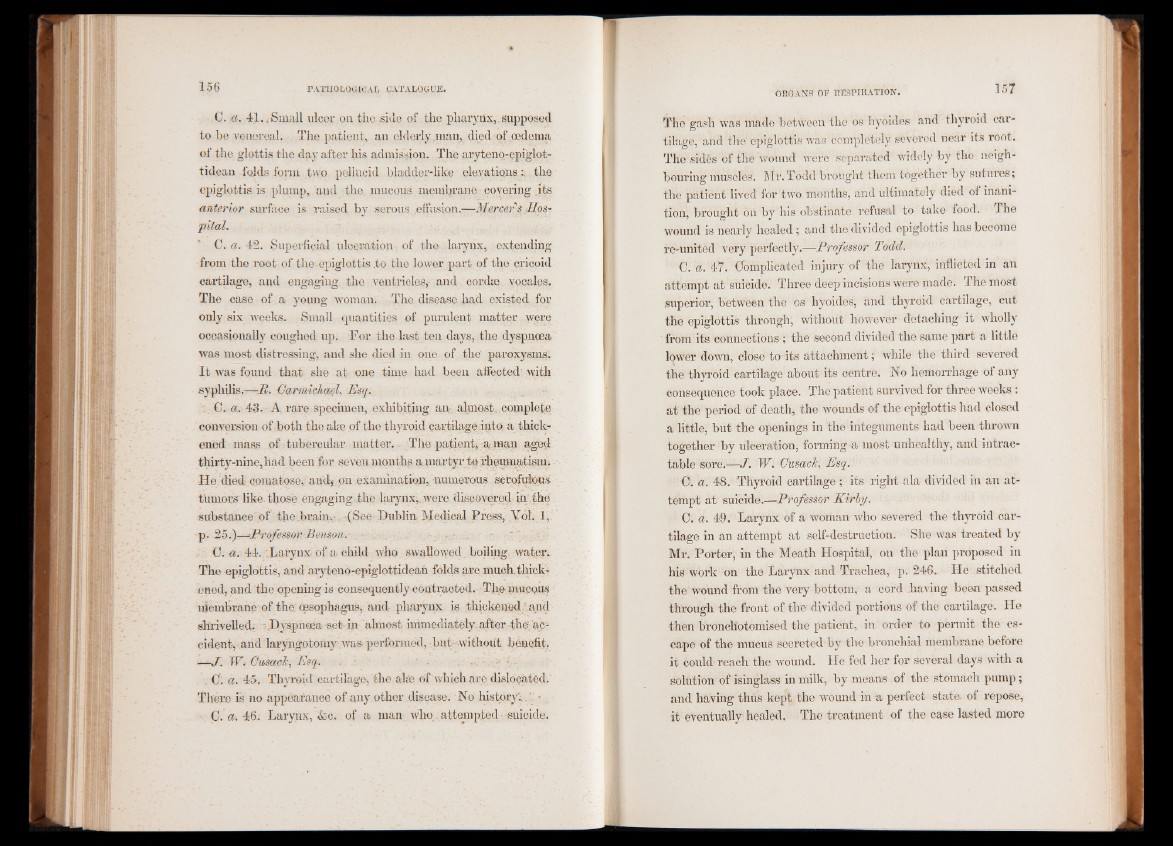
C. a. 1 1 .. Small ulcer on the side of the pharynx,. supposed
to be venereal. The patient, an elderly .man, died of oedema
of the glottis the day after liis admission. The aryteno-epiglot-
tidean folds form two pellucid bladder-like elevationsthe
epiglottis is plump, and the. mucous membrane covering its
anterior surface is raised by serous .effusion.—Mercer's Hospital.
0. a. 42. Superficial ulceration of the larynx, extending
from the root of the-epiglottis .to the lower part of the cricoid
cartilage, and engaging the ventricles,- and cordse vocales.
The case of a young woman. The disease had existed for
only six weeks. Small quantities of purulent matter were
occasionally coughed up. For the last ten days, the dyspnoea
was most distressing, and she died in one of the paroxysms.
It was found that she at one time had been affected' with
syphilis.—-II. Carmichael. Esq. .
: 0.. a. 43. A rare specimen, exhibiting an almost..complete
conversion of both thealse of the thyroid cartilage into, a thickened
mass of tubercular matter. The patient, a man aged
thirty-nine, had been for seven months a martyr to rheumatism.
■ He died comatose, and,- on examination, numerous, scrofulous
tumors like, those engaging.the larynx,. were discovered-in the
substance of the.brain.-. (See Dublin Medical Press, Yol. 1 ,.
p. 25.)—■ Professor Benson.■ .
C. a. 44. Larynx of a child who swallowed boiling water*
The epiglottis, and aryteno-epiglottidean folds are much.thickened,
and the opening is consequently contracted. The mucous
membrane of the'oesophagus, and- pharynx is thickoijod and
shrivelled; 5Dyspnoea set- in almost immediately after -the accident,
and laryngotomy was performed, - but - without benefit.
—-«A W< Cusack, Esq. .
. Cl a. 45, Thyroid cartilage-, the aim of which are dislocated.'
There is no appearance of any other disease. No history'.-. ,:: •
• C. a. 46. Larynx, &c. of a man who attempted -suicide.
The gash was made between the os hyoides and thyroid cartilage,
and the epiglottis was completely severed near its root.
The sides of the wound were separated widely by the neighbouring
muscles. Mr.Todd brought them together by sutures;
the patient lived for two months, and ultimately died of inanition,
brought on by his obstinate refusal to take food. The
wound is nearly healed; and the divided epiglottis has become
re-united very perfectly.—Professor Todd.
0 . a. 4 7 . Complicated injury of the larynx, inflicted in an
attempt at suicide. Three deep incisions were made. The most
superior, between the os hyoides, and thyroid cartilage, cut
the epiglottis through, without however detaching it wholly
from its connections ; the second divided the same part a little
lqwer down, close to its attachment; while the third severed
the thyroid cartilage about its centre. No hemorrhage of any
consequence took place. The patient survived for three weeks ;
at the period of death, the wounds of the epiglottis had closed
a little, but the openings in the integuments had been thrown
together by ulceration, forming a most unhealthy, and intractable
sore.—J. W. Cusack, Esq.
C. a. 48. Thyroid cartilage ; its right ala divided in an attempt
at suicide.—Professor Kirby.
C. a. 49. Larynx of a woman who severed the thyroid cartilage
in an attempt at self-destruction. She was treated by
Mr. Porter, in the Meath Hospital, on the plan proposed in
his work on the Larynx and Trachea, p. 246. He stitched
the wound from the very bottom, a cord having been passed
through the front of the divided portions of the cartilage. He
-then bronchotomised the patient, in order to permit the escape
of the mucus secreted by the bronchial membrane before
it could- reach the wound. He fed her for several days with a
solution of isinglass in milk, by means of the stomach pump;
and having thus kept the wound in -a perfect state- of l’epose,
it eventually healed, The treatment of the case lasted more